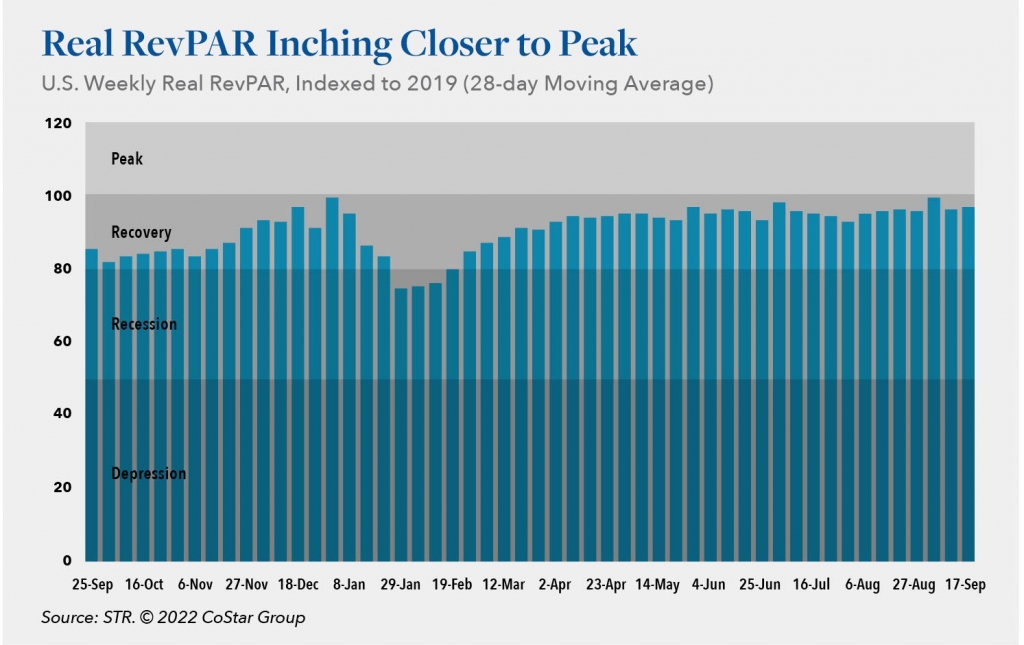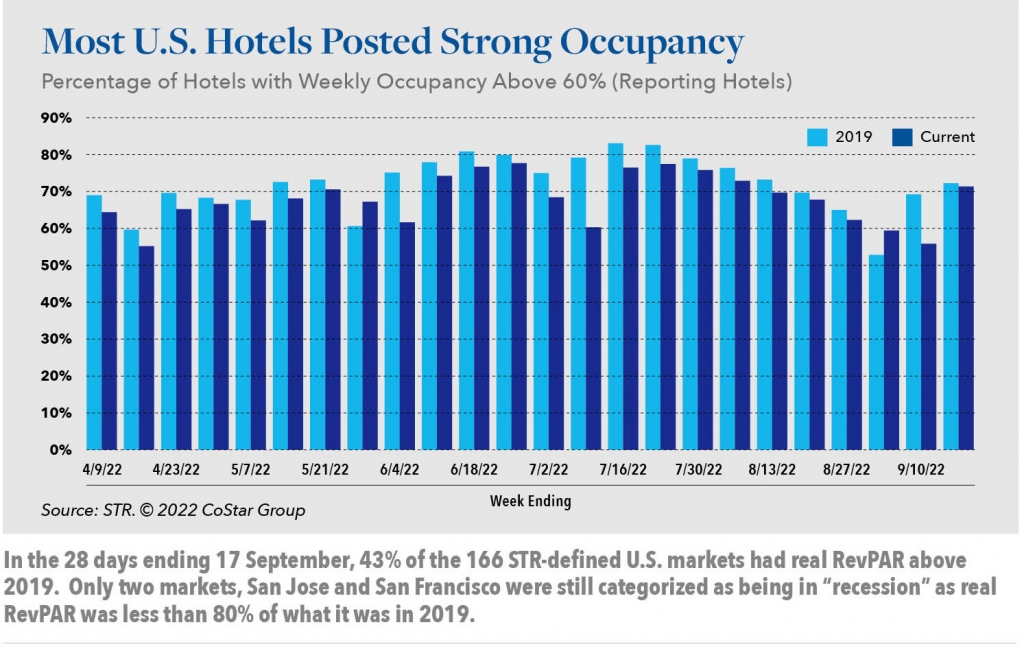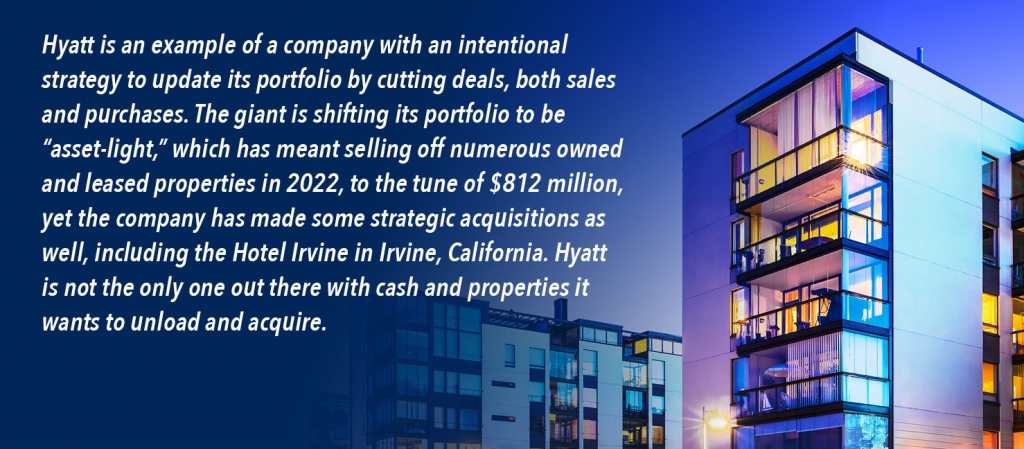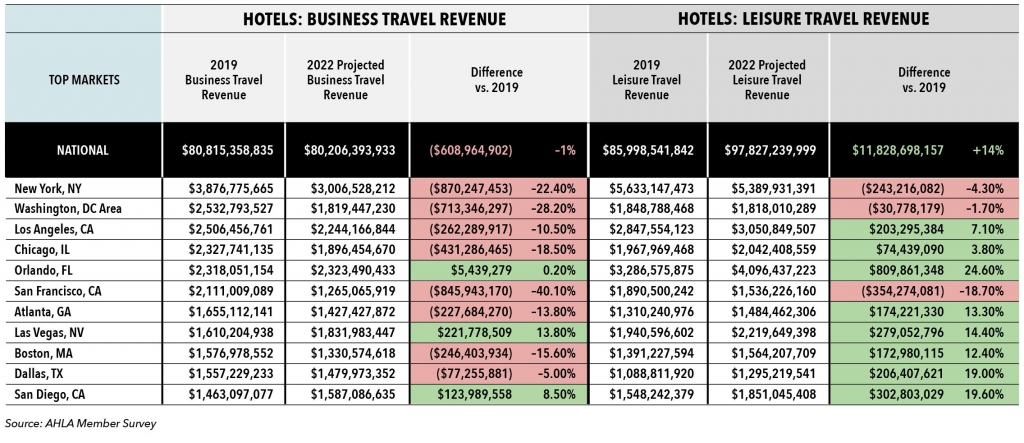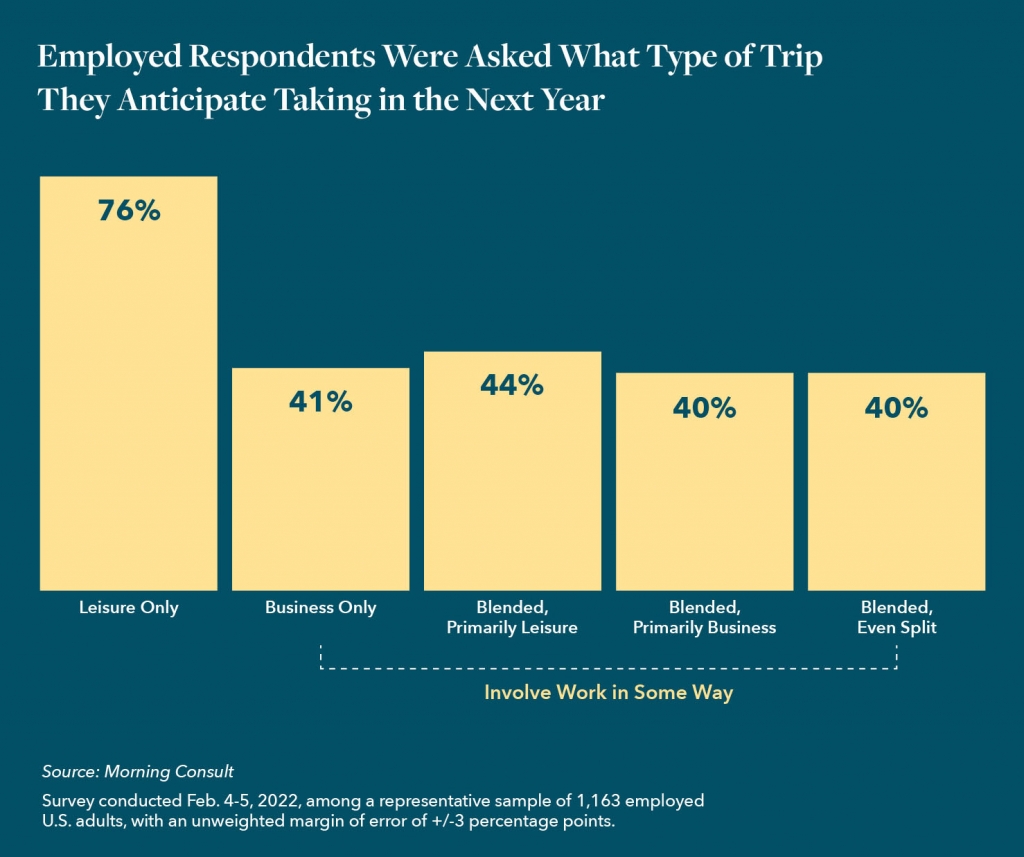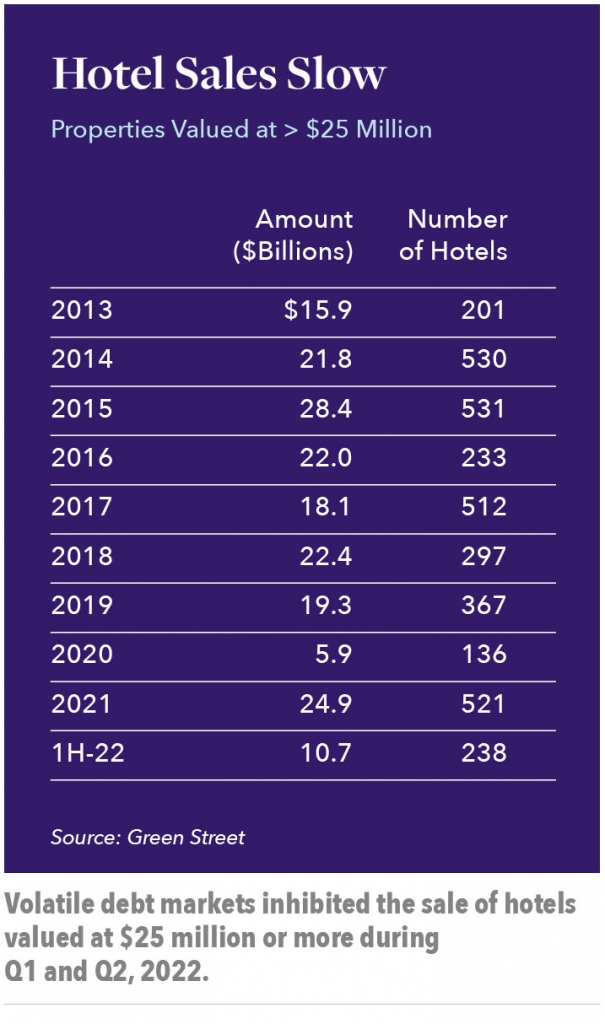
By Keith Worsham
In this article we take a look at the shifting landscape of hospitality industry transactions as post-pandemic travel trends begin to reveal themselves and operators grapple with the ramifications of more than two years of RevPAR setbacks.
A Post-Pandemic Comeback… Of Sorts
Prospects for the hotel industry going into 2023 fall somewhere between somewhat rosy and risky. The hospitality industry gathered in mid-August at the 14th Annual Hotel Data Conference in Nashville, Tennessee to discuss the near-term outlook, and as the editors of Hotel News Now (HNN) shared, “Speakers…acknowledged that the industry still isn’t fully back to 2019 levels across the board, particularly when adjusting for inflation, but it is well ahead of earlier projections.” Even with erratic economic news and inflation at its highest in 40 years, US travelers were on the move. Thus far, the economy has weathered the inflationary pressures and been pretty resilient. Unemployment has remained low and there has been some wage appreciation to temper the persistent inflation, so most people went ahead with travel plans after staying home and saving up in 2021. That’s the somewhat rosy part, which includes healthy average daily rate (ADR) data that is trending up, as well as strong revenue per available room (RevPAR) numbers this year. These figures reflect that TSA checkpoint numbers from September 2022 are almost as robust as 2019, and since May 2022, daily checkpoint numbers have been consistently over 2 million, a milestone reached only sporadically in 2021.
On the riskier side of the equation, persistent inflation, rising interest rates and recession speculation counterbalance some of the positive in the prognosis. While performance against most, if not all, standard hotel indicators improved in 2022, the economy, travel and the world are just not the same since the pandemic. There is enough uncertainty in the mix to make industry watchers tentative about cheering for a full-scale recovery too soon.
All of these factors make it difficult to predict what the next year or so may bring in terms of investment activity in the hospitality arena, but it seems likely that the savviest players in the sector will be working simultaneously on capital improvements to existing properties, acquisitions of new properties, and sales of existing properties. There is likely to be ample opportunity in all three categories of transactions. Deciding how and where to invest will require a great deal of market specific data, as well as a clear understanding of each property’s ability to adapt to the travel landscape of the future.
Leisure/Workplace Dynamics & Travel
U.S. hotel leisure travel revenue is projected to end 2022 14% above 2019 levels, while hotel business travel revenue is expected to come within 1% of 2019 levels, according to a new analysis from the American Hotel & Lodging Association (AHLA) and Kalibri Labs.
The projections are not adjusted for inflation, and real hotel revenue recovery will likely take several more years.
Post-pandemic recovery remains uneven, particularly in many major cities and destinations where business travel continues to lag. Among the top 50 U.S. markets, 80% are projected to see hotel leisure travel revenue exceed 2019 levels, but just 40% are expected reach that milestone for business travel revenue. Many urban markets, which rely heavily on business from events and group meetings, are still on the road to recovery.
The below chart indicates how the top 10 markets for hotel business and leisure travel revenue are projected to fare this year:
According to Morning Consult data, the percentage of frequent business travelers who say they’ll never return to the road ticked up from 39% in October 2021 to 42% in February 2022. A number of companies with historically large travel budgets have indicated they plan to make permanent cuts, at least to some degree. When the dust settles, most estimates are falling in the 15-30% range for long-term cuts to business travel budgets.
Business travel is certainly evolving into something different than before the pandemic. In March 2022, Forbes published a lengthy article titled, “How Covid Changed Business Travel Forever,” written by Suzanne Rowan Kelleher. She interviewed numerous industry executives like Marriott CEO Tony Capuano who said, “Leisure demand has led the recovery, and we are well-positioned to continue growing our lead in resort destinations, including in the high growth all-inclusive space.” Note his pivot from business to leisure without losing a beat.
In reality, the two are getting blurred. A newly coined term—“bleisure”—is being used to describe the mix of business and leisure travel. And according to industry analyst, Lindsey Roeschke in her piece, “When it Comes to Travel, Blended is the New Business,” “[There may be] preconceived notions about blended trips — that they’re long or perhaps even multi-destination affairs, or that such travelers flock to vacation rental sites like Airbnb and Vrbo instead of hotels. In reality, the majority of these trips will be less than a week in length, and traditional hotels tend to be the preferred accommodation, which opens the door for hotels to provide the amenities these travelers seek.” She points out that professional flexibility is changing travel behaviors. To the extent that more nuanced work schedules and diverse work venues are here to stay, travel habits are likely to evolve in sync.
Roeschke points out that hotels have a lot of opportunity to capture these blended stays. She discounts the vacation rental sites, but there is no denying the increased role those sites are playing in the travel accommodations space since COVID. In the aforementioned Forbes piece, the CEO of Airbnb, Brian Chesky, is quoted from the company’s Q4 2021 earnings call saying, “Nearly two years into the pandemic, it’s clear that we are undergoing the biggest change to travel since the advent of commercial flying.” That is just one of the ways he talks about how the pandemic has impacted Airbnb’s bottom line. If business travel will never be the same, hotel owners and operators have some work to do to accommodate travelers’ evolving needs. They need to compete effectively with Airbnb, Vrbo, and others that are offering more attractive and amenity rich experiences.
Mass layoffs in the hospitality sector during the pandemic have come back to haunt the industry in the form of critical staffing shortages. Staff levels in turn have an impact on the guest experience. Guests’ expectations are on the rise and competing with the likes of vacation rental sites with their long list of amenities is paramount to the hotel industry’s ability to capture a good portion of the post-pandemic travel pie. No doubt travelers plan to keep rentals in the mix, and ongoing interest in alternative accommodations will likely continue to push hospitality providers to be creative. Hotels that elevate home-like amenities, such as kitchens, adjoining rooms, and workspaces stand a better chance to capture some of these trips.
Economics, Capital Markets & the Hospitality Space
Buying, selling and repositioning of hotel properties is on the uptick in 2022. Rising interest rates have served to put the brakes on some transactions, but there was a lot of buying and selling activity in the first half of 2022. The LW Hospitality Advisors (LWHA) Q2 2022 Major U.S. Hotel Sales Survey included 60 single asset sale transactions over $10 million, totaling $4.7 billion and including approximately 14,000 hotel rooms with an average sale price per room of $331,000. When comparing Q2 2022 with Q2 2021, the survey found that number of trades increased by approximately 122 percent while total dollar volume grew roughly 12 percent. Sale price per room, however, declined by 25 percent. For comparison, LWHA’s pre-pandemic survey in Q2 of 2019 identified 35 transactions totaling roughly $2.6 billion including 9,100 hotel rooms with an average sale price per room of $286,000. Comparing these two periods (Q2 2022 and Q2 2019), the number of trades increased by nearly four times, while total dollar volume more than doubled. Sale price per room, however, was roughly 13 percent lower.
In the second half of 2022, there are numerous opportunities to get involved in deals, the challenge being finding the financing source that best suits the opportunity. More expensive capital is impacting the number of transactions and prices of transactions getting closed. While financing might be more scarce and more costly because of the associated risk right now, there remain well-financed investors looking for deals. However, these buyers are taking more time in analyzing projections and performing diligence. Clearly, the leverage has now swung to favor purchasers.
Some serious challenges lay ahead for the numerous owners and operators with less attractive balance sheets, many of whom will be looking for buyers too. These types of transactions are facing tougher headwinds with the interest rate increases, inflationary pressures and jitters about a potential recession. And, for any hospitality borrowers who are in trouble, refinancing will be expensive at best and unattainable at worst. This may give some buyers more leverage, particularly if they are nimble and have funds readily available.
Volatile debt markets inhibited the sale of hotels valued at $25 million or more during Q1 and Q2, 2022.
Conclusions
Clearly, the recovery has not been even across all segments of the industry and we are now observing increased incidence of downward pricing pressure on various hospitality assets. Many existing hotel properties are in dire need of renovations, which were deferred as flags relaxed their standards during the COVID-19 outbreak. In many cases, these are now being enforced once again. That, in combination with continued labor shortages and supply chain disruptions is creating serious challenges for operators. The same issues are also creating a backlog in new hotel openings as developers struggle to complete existing projects and secure reasonable financing for proposed new properties.
The ongoing threat of a global recession and geopolitical uncertainty in eastern Europe, Asia and elsewhere has created an uncertain growth roadmap for the industry, leading to greater underwriting risk for investors. Meanwhile, capital raised and earmarked for COVID-period distress relief sits idle and losing value during this inflationary period.
Even as RevPAR improves, going into 2023 we are likely to see an increase in the number of distressed hotel and other deals, as many pandemic-impacted operators are faced with no real option other than to sell into a market flush with inventory. With financing complex and capital expensive right now based on associated risk, the number of transactions taking place and the prices being paid to get deals closed have been notably affected. Importantly, however, the spigot has not been shut off for appropriately structured transactions given the continued interest of industry-savvy buyers and financing sources. This is particularly true for those who can bring added resources expertise well suited to the evolution of the industry and adept in the art of dynamic pricing structure and implementation.
The buyer pool for hospitality deals may be shrinking, but equity funds, family offices and institutional investors are all in a good position to take advantage of the situation. In addition to companies like Hyatt looking to reposition their portfolios, there will be turnaround opportunities in a number of hospitality markets, particularly ones that can be positioned as attractive places to both work and vacation, for example those with a good airport and proximity to outdoor recreation.


